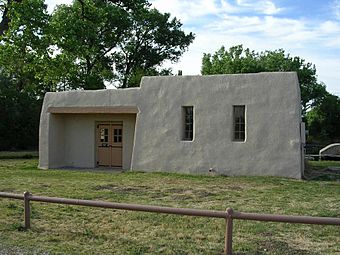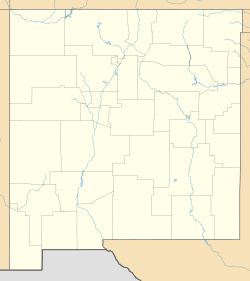Rattlesnake Springs Historic District facts for kids
|
Rattlesnake Springs Historic District
|
|

Pump House
|
|
| Nearest city | Carlsbad, New Mexico |
|---|---|
| Area | 24 acres (9.7 ha) |
| Architect | Harvey Cornell |
| Architectural style | Late 19th And 20th Century Revivals, Pueblo, New Mexico Territorial |
| NRHP reference No. | 88001130 |
Quick facts for kids Significant dates |
|
| Added to NRHP | July 14, 1988 |
The Rattlesnake Springs Historic District is a special place in New Mexico. It's a small, separate part of Carlsbad Caverns National Park. Imagine a desert, and then suddenly, a green, watery spot! That's what Rattlesnake Springs is. It's an oasis in the dry Chihuahuan Desert.
This area is important because it has a natural spring. This spring provides water, making it a home for many plants and animals. It's also a historic district, meaning it has old buildings and features that tell a story about the past.
A Desert Oasis
Rattlesnake Springs is like a hidden gem in the desert. It's a place where water comes up from the ground. This water helps plants grow, creating a green area. This green spot stands out in the dry Chihuahuan Desert.
The spring makes it a perfect home for many different kinds of birds. Bird watchers love to visit Rattlesnake Springs. It's a key spot for birds that are migrating or living in the desert.
History of the Springs
The story of Rattlesnake Springs goes back a long time. In 1880, a man named William Henry Harrison settled here. He was a homesteader, which means he claimed land to live on and farm. He even said he was related to a U.S. President named William Henry Harrison.
To grow crops, William Henry Harrison built a system of ditches. These ditches helped bring water from the spring to his fields. This old ditch system is still there today. It's one reason why the area looks so green and cared for.
William Henry Harrison lived at the springs until he passed away in 1930. After that, the National Park Service bought the land. They needed the water from the springs for Carlsbad Caverns National Park. The park is about 6 miles (10 km) away.
Building the Park
Once the National Park Service owned the land, they started to make changes. They wanted to protect the area and make it useful for the park. They got help from a group called the Civilian Conservation Corps (CCC). The CCC was a program during the Great Depression. Young men worked on projects to improve parks and natural areas.
CCC workers helped remove most of the old farm buildings. They also continued to make the area look nice. A CCC camp was set up right at Rattlesnake Springs. The young men lived and worked there.
During World War II, the CCC camp was no longer used by the CCC. Instead, it became a fun place for soldiers from a nearby air base. But by the 1950s, the camp buildings were taken down.
Buildings and Nature
The National Park Service built new structures at Rattlesnake Springs. These buildings were designed to fit in with the area. Some were designed by Ken Saunders and Del Jones. They worked for the Park Service in Santa Fe.
One important building is the Ranger's Residence. It was built in 1940. Another key building is the Pump House, built in 1933. William G. Carnes designed the Pump House. It was built in the Pueblo Revival style. This style looks like traditional Native American Pueblo buildings.
Besides the buildings, the natural features are also important. William Henry Harrison had planted a fruit orchard. The National Park Service also added more plants and landscaping. These natural elements are a big part of what makes Rattlesnake Springs special.
The Rattlesnake Springs area was officially recognized as a historic place on July 14, 1988. It was added to the National Register of Historic Places. This means it's a place that is important to the history of the United States. It's still a wonderful place to visit, especially if you love birds!



